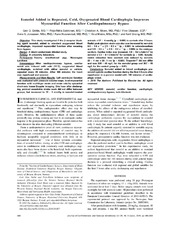Esmolol added in repeated, cold, oxygenated blood cardioplegia improves myocardial function after cardiopulmonary bypass
Dahle, Geir Olav; Salminen, Pirjo-Riitta; Moen, Christian Arvei; Eliassen, Finn; Jonassen, Anne K.; Haaverstad, Rune; Matre, Knut; Grong, Ketil
Peer reviewed, Journal article
Published version
Permanent lenke
https://hdl.handle.net/1956/10481Utgivelsesdato
2015-06Metadata
Vis full innførselSamlinger
Originalversjon
https://doi.org/10.1053/j.jvca.2014.09.017Sammendrag
Objective: This study investigated if the β-receptor blocking agent esmolol, added to standard oxygenated blood cardioplegia, improved myocardial function after weaning from bypass. Design: A block-randomized, blinded study. Setting: A university laboratory. Participants: Twenty anesthetized pigs, Norwegian Landrace. Interventions: After cardiopulmonary bypass, cardiac arrest was induced with cold (12°C), oxygenated blood cardioplegia, enriched with either esmolol or vehicle, repeated every 20 minutes. After 100 minutes the heart was reperfused and weaned. Measurements and Main Results: Left ventricular function was evaluated with pressure-volume loops, local myocardial function with multilayer strain and strain rate by epicardial short-axis tissue Doppler imaging. One hour after declamping, preload recruitable stroke work did not differ between groups, but increased to 72±3 mmHg in esmolol-treated animals v 57±4 mmHg (p<0.001) in controls after 3 hours. Radial peak ejection strain rate also was increased by esmolol; 6.0±1.0 \(s^{-1}\) v 2.9±0.3 \(s^{-1}\) (p<0.001) in subendocardium and 3.9±0.5 \(s^{-1}\) v 2.3±0.2 \(s^{-1}\) (p<0.005) in the midmyocardium. Cardiac index was increased, 4.0±0.2 L/min/$$m^2\) by esmolol v 3.3±0.1 L/min/m2 for controls (p<0.05). Isovolumetric relaxation time constant was reduced by esmolol, 23±1 ms v 26±1 ms (p<0.025). Troponin-T did not differ and was 339±48 ng/L for the esmolol group and 357±55 ng/L for the control group (p = 0.81). Conclusions: Esmolol added to blood cardioplegia preserved systolic cardiac function during the first 3 hours after reperfusion in a porcine model with 100 minutes of cardioplegic arrest.

